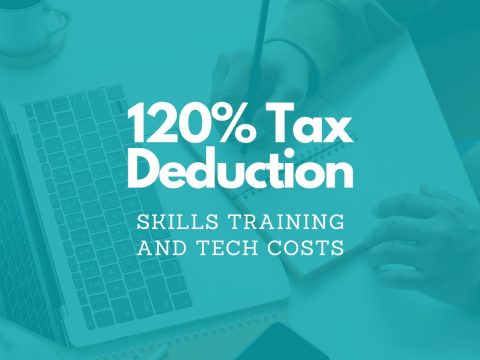DIY video marketing tips for small businesses and entrepreneurs
If you are interested in experimenting with video marketing, here are some tips on just getting started! The first step is often the hardest, right?
For many small businesses, video production is often put in the “too hard basket.” It’s too expensive, too time-consuming, too frightening… the list goes on! As with anything that is expensive, time-consuming and/or frightening, video is easy to deprioritise in the whirlwind that is everyday business.
The stats are hard to ignore though. YouTube recently reported that 2 billion logged-in users visit each month, racking up billions of hours viewed. Each month. Interestingly, more than 70% of this activity now happens on mobile devices. According to Cisco, global video traffic will make up 82% of all web traffic (business and consumer) by 2022! They also estimate that, by then, 17% of Internet video traffic will be live (e.g. broadcast via Facebook or YouTube).
In 2016, Google reported that almost 50% of Internet users look for videos about products before seeing them in store – a number which has probably increased since then! Fun fact: according to Business Insider, the highest-earning YouTube channel of 2018 was Ryan ToysReview, where a 7-year-old host (with a bit of help from his family) reviews toys for other kids and their parents. They made USD $22 million!
We know that YouTube has also become a trusted source of tutorial videos on a mind-boggling range of topics, as well as nostalgia; where else would you go to look for that childhood cartoon you loved?
Seeing the rise of video content everywhere, many business owners and professionals are now making the leap from video consumer to creator. However, this is where many get stuck. Here are some possible reasons why:
- They haven’t figured out why exactly: there are many different reasons to produce marketing videos, sometimes in driving a particular outcome (e.g. launching a new promotion or announcing a new product), building brand awareness (e.g. introducing team members or sharing a recent win) and more; videos can even be produced as their own product (e.g. an online training course presented by an executive coaching or consulting business) and create a whole new income stream. If you don’t have a good and motivating reason, inertia will set in and it’ll be back to business-as-usual in no time! Once you have a clear reason as to why, you can think about where the videos will be distributed and the quality implications this will have. You can produce a very different (i.e. much simpler and cheaper) video for your own personal LinkedIn profile as opposed to a TV network. This post focuses on the former case, where you’re utilising your owned (not paid) media.
- They haven’t thought about where: just looking at your owned media alone, there are so many different places to host and share your videos (e.g. your websites, landing pages, blogs, Facebook, LinkedIn, YouTube, Vimeo, etc.) and different channels often benefit from slightly different approaches. If you don’t have great web traffic but a strong social media following on Facebook, a video hosted natively on Facebook may be the right choice. Given most users will be watching from their mobiles, your video could have a portrait orientation (i.e. if shot on your mobile) and – though slightly more difficult to implement – would benefit from subtitles for all the people silently scrolling while commuting and for accessibility reasons. So, thinking about the media is another place people get stuck. The sheer range of options, uncertainty around which channel(s) to choose and how to approach each one slightly differently can be crippling.
- They haven’t learned how: those who don’t have TV budgets (i.e. a lot of us) will probably be using their owned media for distribution and having real team members (or themselves) feature in their videos. I think this can be great for authenticity reasons. But we encounter two common problems for small businesses:
- The first is building an online following. Take the earlier example about having a strong Facebook following; what if there isn’t one? What if the company doesn’t have any social followings or much web traffic? Well, this is a broader business problem and a prerequisite to shooting videos that are going to perform well. Your first video probably won’t go viral, so pre-existing followers are a good thing to invest time in. Here’s an important point: you may want to shoot videos but hiring a production agency may not be the next step. An in-house marketing coordinator or social media agency could come first to help build the right audience for your brand. Having said that, always use what you have. Even if the company’s social pages aren’t huge yet, your own LinkedIn following may be large and influential enough and you can start with a personal “hello” to them – why not? You might produce a video for your own staff and just email them a link. You might produce a video just for your existing client base and add it to your next company newsletter. Always thinking a video needs to be public and “go viral” clouds our judgement and closes off the many other possibilities and uses of video marketing. It also causes us to approach video agencies too soon and overspend.
- The second problem is just a lack of confidence around shooting a video (yes – even using your own mobile phone). A tripod or holder will help stabilise things at very low cost and (this is important) an external microphone that plugs in to your headphone jack or connects wirelessly will help boost the all-important sound quality. Simple editing may be required, but you could use basic editing software (even on your phone) just to trim the beginning and end of any fat and even add your logo. However, I would suggest the videos intended for social media actually stay as unedited as possible – it shouldn’t look like you hired a cheap agency and received a poor result. A “Hi, it’s me!” video should look DIY. No fancy graphics, intros, outros… just you. Let your professionally shot videos have all the bells and whistles.
- They overcomplicate and overspend: the default when a business owner thinks of producing a video still seems to be engaging a professional video production agency. And for some types of video, with certain types of goals and media in mind, that is definitely the way to go. Don’t shoot your own TV ad, for example. However, we’re not usually producing TV ads, are we? There’s a whole host of video types you could be producing on a near day-to-day basis just to engage your staff members or keep your current clients updated. You could shoot a tutorial video to help a new starter learn their role. Or just provide a welcome video personalised for them. You could shoot a company update, good news story, client testimonial or birthday singalong – all from your mobile phone. These things often happen spontaneously and there’s just no time to call in the big guns. Just remember your tripod and mic where possible! Now, not all of these videos will be suitable for your official company channels, but some will – and your followers will enjoy seeing such authentic, real content. There’s nothing wrong with this. Bring in the agency to cover a major product launch, ‘about us’ videos for your website or any time you are spending some serious media dollars. Having advocated the DIY approach, I should also say that some agencies are becoming increasingly competitive too, so – if you shop around – you should be able to find someone you could partner with and reliably outsource to. But don’t think you and your own staff are incapable of filling the gaps in between professional shoots!
So, when it comes to video production for business, there are many ways to do it and many places to share it. There are many potential audiences and many potential messages. Don’t default to the award-winning agency touting the viral potential of your first video; it will become an expensive and potentially disappointing exercise that is difficult to replicate on a regular basis in an area where consistency is key. If you are a trusted subject-matter expert in your field, your online followers would probably rather see a monthly video of your musings shot on a phone at your desk rather than a single yearly brand advertisement full of professional actors.
There’s so much more to say on this topic but, for now, remember: if you have found a good reason to shoot videos in your business, see what resources you already have on hand (in terms of camera equipment, talent and messages) and what you can easily acquire. Seek some advice from people who have done it well (you may be seeing their hand-held videos racking up serious likes and comments on LinkedIn, for example) and any industry professionals you may know. Use common sense: don’t use copyrighted images and music without permission and don’t create unnecessary risk. Have reasonable minimum production values (in terms of picture resolution, stability and audio) so that you can be understood and achieve a connection. Make it an exercise that feels achievable and repeatable so that you can publish with a level of consistency – and watch the response from your online followers to change your approach if needed!
With thanks to our guest author: Shahe Momdjian, Managing Director at Young Wisdom Content Marketing




